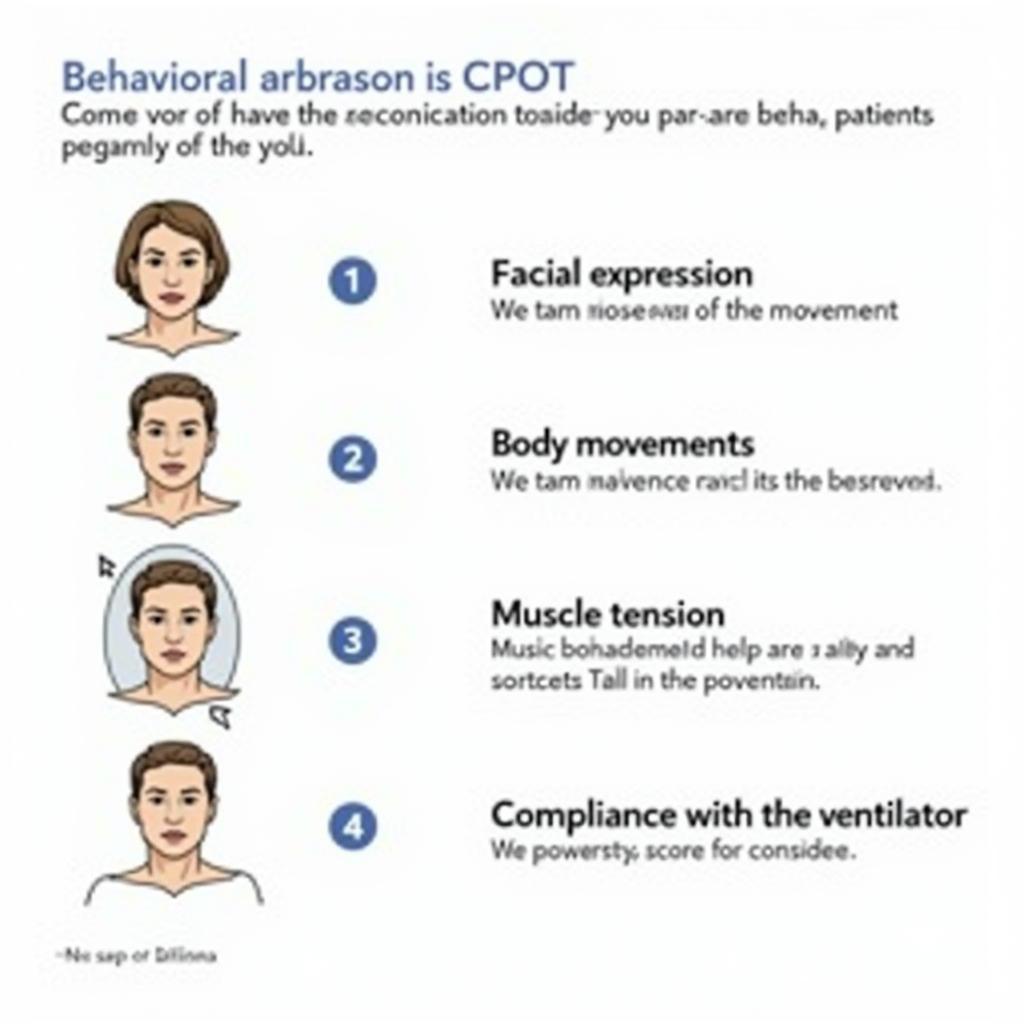The Critical-Care Pain Observation Tool (CPOT) is a valuable instrument for assessing pain in patients who are unable to communicate verbally, typically in critical care settings. This tool helps healthcare professionals provide appropriate pain management, improving patient comfort and overall outcomes. Understanding the CPOT, its application, and limitations is essential for effective pain management in the ICU.
What is the Critical-Care Pain Observation Tool (CPOT)?
The CPOT is a pain assessment tool designed specifically for critically ill adults who are sedated, intubated, or otherwise unable to self-report pain levels. It observes four behavioral indicators: facial expression, body movements, muscle tension, and compliance with ventilator (or vocalization if not intubated). Each indicator is scored on a scale of 0-2, with a total score ranging from 0 (no pain) to 8 (severe pain).
 CPOT Assessment Indicators
CPOT Assessment Indicators
CPOT scores are then interpreted to determine the level of pain experienced by the patient. Scores of 0-1 typically indicate no pain, while scores of 2-3 suggest mild to moderate pain. Scores of 4 or higher indicate significant pain and warrant prompt intervention.
Why is the CPOT Important in Critical Care?
Pain is a common experience for critically ill patients and can have detrimental effects on their recovery. Unmanaged pain can lead to increased anxiety, stress, and even delirium. It can also negatively impact physiological parameters, such as heart rate, blood pressure, and respiratory rate. The CPOT allows healthcare professionals to objectively assess pain in these vulnerable patients and implement appropriate interventions to alleviate their suffering.
 CPOT Use in ICU
CPOT Use in ICU
How to Use the CPOT Effectively
Using the CPOT involves systematic observation and scoring of the four behavioral indicators. First, observe the patient at rest. Then, if the patient is receiving mechanical ventilation, observe their compliance with the ventilator. If they are not intubated, observe their vocalization. Next, assess the patient’s facial expression, body movements, and muscle tension. Score each indicator based on the provided criteria, and sum the scores to obtain the total CPOT score.
Limitations of the CPOT
While the CPOT is a valuable tool, it’s important to be aware of its limitations. It relies on behavioral observations and is therefore subjective. It cannot assess pain in patients with neuromuscular blocking agents, and certain medical conditions can mimic pain behaviors. Furthermore, it’s crucial to consider individual patient factors, such as baseline behavior and cultural differences, when interpreting CPOT scores.
CPOT and Other Pain Scales
The CPOT is often used in conjunction with other pain assessment tools, such as the Behavioral Pain Scale (BPS) and the Richmond Agitation-Sedation Scale (RASS). These tools provide a more comprehensive assessment of pain and sedation in critically ill patients.
“Accurate pain assessment is paramount in critical care. The CPOT is a vital tool that helps us understand and manage pain in our most vulnerable patients.” – Dr. Emily Carter, Critical Care Specialist
Conclusion: The Importance of the Critical-Care Pain Observation Tool (CPOT)
The CPOT plays a crucial role in pain management in critical care settings. By enabling healthcare professionals to identify and address pain in patients who cannot communicate, the CPOT improves patient comfort, facilitates recovery, and enhances overall quality of care. Understanding the tool, its applications, and limitations are essential for all clinicians working with critically ill adults. Continuous training and interdisciplinary collaboration further enhance the effectiveness of the CPOT in promoting optimal patient outcomes.
FAQ
- What does CPOT stand for? CPOT stands for Critical-Care Pain Observation Tool.
- Who is the CPOT used for? It’s used for critically ill adults unable to communicate their pain.
- What are the four indicators in CPOT? Facial expression, body movements, muscle tension, and compliance with the ventilator (or vocalization).
- What is the scoring range for CPOT? The CPOT score ranges from 0 (no pain) to 8 (severe pain).
- What are the limitations of CPOT? It is subjective, cannot assess pain in patients with neuromuscular blockers, and requires consideration of individual patient factors.
- Why is pain management important in critical care? Unmanaged pain can hinder recovery and negatively impact physiological parameters.
- What other pain scales are used in the ICU? BPS (Behavioral Pain Scale) and RASS (Richmond Agitation-Sedation Scale).
Other Relevant Articles
- Pain Management in the ICU
- Understanding the Behavioral Pain Scale
- The Richmond Agitation-Sedation Scale: A Guide for Clinicians
Need help? Contact us via WhatsApp: +1(641)206-8880, Email: [email protected], or visit us at 910 Cedar Lane, Chicago, IL 60605, USA. We have a 24/7 customer support team.

Leave a Reply